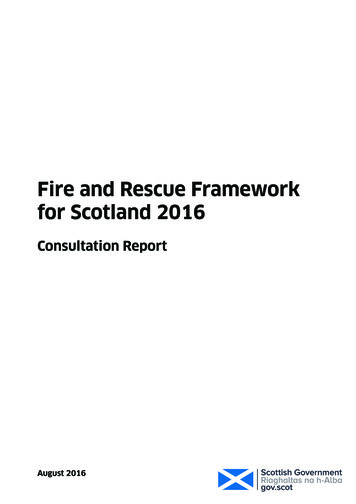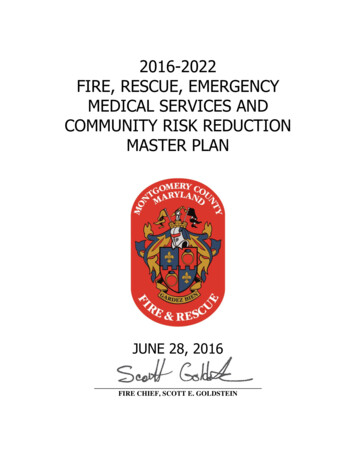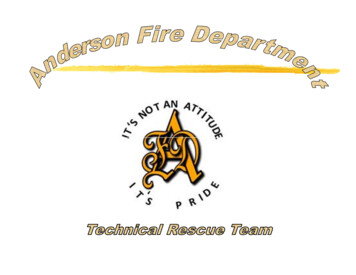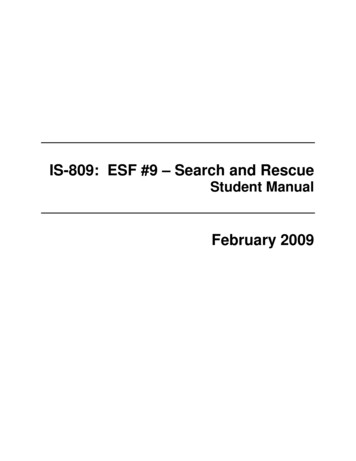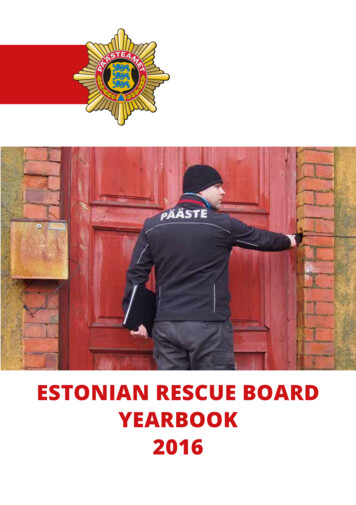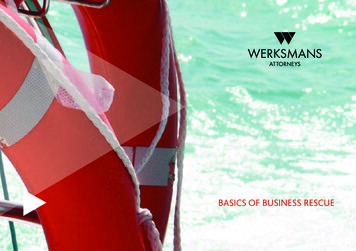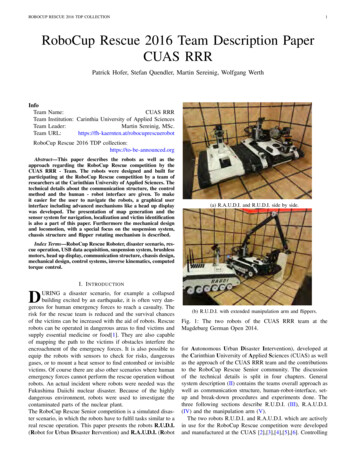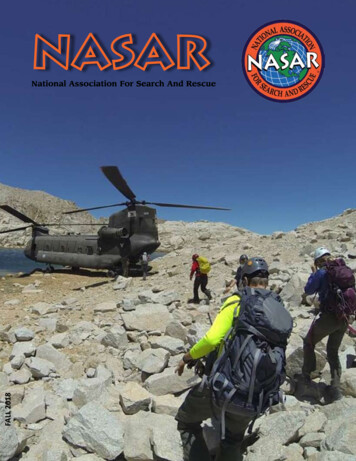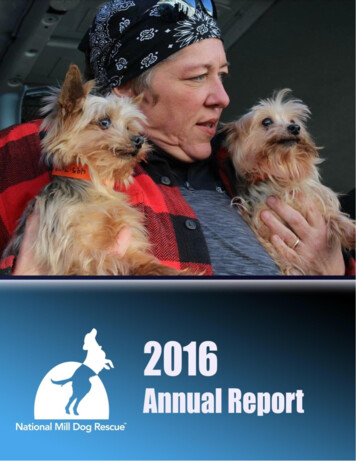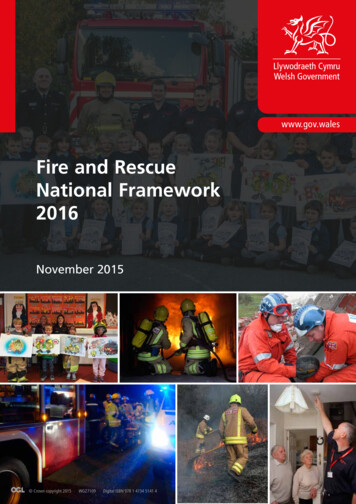
Transcription
Fire and RescueNational Framework2016November 2015 Crown copyright 2015WG27109Digital ISBN 978 1 4734 5141 4
FIRE AND RESCUE NATIONAL FRAMEWORK FOR WALES 2016CONTENTSINTRODUCTION . 3Powers . 3VISION AND KEY PRIORITIES . 4The changing context of fire and rescue services . 4The Well-being of Future Generations (Wales) Act 2015 . 5Status of this Framework . 6CHAPTER 1: CONTINUALLY AND SUSTAINABLY REDUCING RISK ANDENHANCING THE SAFETY OF CITIZENS AND COMMUNITIES . 7Identifying risk and targeting interventions . 7Business Fire Safety . 8Primary Authority for Fire Safety . 9Designing and evaluating programmes . 9Engaging people and communities . 9Diversifying programmes . 10Collaboration and prevention . 10CHAPTER 2: RESPONDING SWIFTLY AND EFFECTIVELY TO INCIDENTS . 13Assessing and responding to changing risk . 13Safe and effective responses. 14Non-mandatory functions . 15CHAPTER 3: BEING CLEARLY AND PUBLICLY ACCOUNTABLE FORDELIVERY AND FUNDING, MANIFESTING IN THE HIGHEST STANDARDS OFGOVERNANCE. 17Public accountability . 17Medium to Long Term Planning . 17Links to Improvement Planning . 18FRA Members . 19Role of Local Authorities. 19Future of FRA governance . 20CHAPTER 4: MAINTAINING DOWNWARD PRESSURE ON COSTS AND TAKINGALL OPPORTUNITIES TO REALISE EFFICIENCIES . 21Benchmarking . 211
Funding and budget-setting. 22Opportunities for efficiency . 23CHAPTER 5: WORKING EFFECTIVELY WITH PARTNERS TO IMPROVEEFFICIENCY AND CITIZEN AND COMMUNITY WELL-BEING . 25Collaboration to achieve efficiency . 26Collaboration with each other and with Fire and Rescue Services outsideWales. 26Collaboration to support the wider public service . 27Information Sharing . 27Review arrangements . 27CHAPTER 6: VALUING AND DEVELOPING THE WORKFORCE TO THEHIGHEST STANDARDS . 29Firefighter Fitness . 29Health and well-being . 29Training . 30Review. 30CHAPTER 7: IMPLEMENTATION, MONITORING AND REPORTING . 32Intervention . 32Roles and responsibilities. 33Relationships . 342
INTRODUCTIONPowersUnder section 21 of the Fire and Rescue Services Act 2004 (“the 2004 Act”) theWelsh Ministers must prepare a Fire and Rescue National Framework.The section provides that the Framework—(a)must set out priorities and objectives for Fire and Rescue Authorities (FRAs) inconnection with the discharge of their functions;(b)may contain guidance to FRAs in connection with the discharge of any of theirfunctions;(c)may contain any other matter relating to FRAs or their functions that the WelshMinisters consider appropriate.In preparing the Framework the Welsh Ministers are required to consult FRAs,persons representing employees of FRAs, and any other persons they considerappropriate. This requirement has been discharged by undertaking a full publicconsultation prior to the publication of this document.In this Framework the term ‘FRAs’ refers to the three statutory bodies responsible forproviding fire and rescue services in Wales, i.e. the North Wales Fire and RescueAuthority, the Mid and West Wales Fire and Rescue Authority and the South WalesFire and Rescue Authority.3
VISION AND KEY PRIORITIESThe Fire and Rescue National Framework sets out the Welsh Government’s visionand priorities for FRAs in Wales. It describes what the Welsh Government expectsof the FRAs and creates the foundation on which to build and promote improvement,efficiency and innovation.FRAs have a critical and highly-valued role in making and keeping people safe.Their capability and expertise has contributed to a significant and sustainedreduction in both the incidence of fires in Wales and their severity in terms of deathsand injuries. But that same success has meant the role of FRAs is changing. Itsresources can be, and increasingly are, diverted to deal with other incidents, and toimprove fire safety and fire prevention. It is no longer appropriate to see FRAs assimply a means of responding to and fighting fires when they arise, although that is,of course, still essential. The overriding aim of FRAs should be broader than that. Itshould be:To keep people, communities, businesses and the environment in Wales safefrom fires and other hazards as effectively and efficiently as possible.This Framework expands on this overriding aim and sets out how FRAs shouldpursue it. Doing so will entail a process of change in what FRAs do and how they doit. To a certain extent that process is already under way, led by the FRAsthemselves. While the Welsh Government welcomes that, we believe the directionof travel needs to be more clearly structured and articulated at an all-Wales level.The Framework fulfils that need.The changing context of fire and rescue servicesA need for organisations to change is often interpreted solely as a criticism of howthey have operated in the past. That is not the case here. The contribution whichFRAs have made to improving safety is clear. This Framework does not advocatechange as a response to under-performance, mismanagement or inefficiency.Rather, it does so because the context in which FRAs operate and the challengesthey face are themselves changing.There are three main aspects of that: An effective balance between response and prevention. As noted above,there has been a long-term decline in the incidence of fire. This reflectsFRAs’ work in promoting fire safety. While a reduction in fires clearly cannotand should not yield an equivalent increase in available capacity, this trenddoes free up some further firefighting resources to be diverted to such work.This is a significant achievement. It improves both the safety of people andcommunities and the efficiency of the Service: it is far more cost-effective toprevent a fire than to fight one. However, achieving and sustaining thatbalance will mean changes in responsibilities, capabilities, structures, skillsand cultures – and how these are managed, monitored and improved;4
Austerity. While FRAs are in the unique position of determining their ownbudgets, they need to do so in a context of severe medium to long-termpressure on public finances. That in turn calls for sustained maximum effort inidentifying and realising efficiencies, in maintaining high standards ofgovernance, and in accounting transparently for delivery. It also reinforcesthe need to reduce costs by preventing, rather than responding to fires; An aging population. The population of Wales is growing older, withparticularly marked increases in the number of people who are aged over 80.At the same time, there is a sustained shift from residential to home-basedcare for all vulnerable groups. These trends will tend to increase the numberof people who are at severe risk of fire, and disperse those risks more widelyacross the community. That increases both the need to focus on preventionand to collaborate with other agencies in doing so.These challenges are clearly interlinked. Both austerity and aging call for a greaterfocus on prevention, which improves the safety of vulnerable people. Meeting thesechallenges calls for clear and coherent leadership and action by the FRAs, by theWelsh Government and by partner agencies. This Framework sets out what thatshould entail. In particular, it specifies the following key objectives for FRAs: Continually and sustainably reducing risk and enhancing the safety ofcitizens and communities (chapter 1); Responding swiftly and effectively to incidents (chapter 2); Being clearly and publicly accountable for delivery and funding,manifesting the highest standards of governance (chapter 3); Maintaining downward pressure on costs and taking all opportunitiesto realise efficiencies (chapter 4); Working effectively with partners to improve efficiency and citizen andcommunity well-being (chapter 5); Valuing and developing the workforce to the highest standards (chapter6).The Well-being of Future Generations (Wales) Act 2015The National Assembly for Wales passed the Well-being of Future Generations(Wales) Act 2015 in March 2015. It specifies seven well-being goals, requires mostdevolved public bodies to set objectives for meeting those goals, and to pursuethose objectives in accordance with the sustainable development principle.5
This Framework has been designed so that following it will support compliance withthe Well-being of Future Generations (Wales) Act 2015. For instance, reducing therisk and incidence of fire will contribute directly to the goals of A Healthier Wales andA Wales of Cohesive Communities; action to minimise the risk and incidence of firein respect of the natural environment and heritage assets will likewise contribute tothe goals of A resilient Wales and A Wales of vibrant culture and thriving Welshlanguage.Equally, the approaches which this guidance sets out are designed to be whollyconsistent with the sustainable development principle. Effectively balancingresponsive and preventative services is at the heart of that: it squarely supports the‘long term’ and ‘prevention’ aspects of that principle. Other elements of thisFramework also support the ‘integration’, ‘collaboration’ and ‘involvement’ aspects.Status of this FrameworkThis Framework is prepared by the Welsh Ministers under section 21 of the Fire andRescue Services Act 2004, and brought into effect by the Fire and Rescue Services(National Framework) (Wales) Order 2015. FRAs must, under section 21(7) of the2004 Act, therefore have regard to it in exercising their functions. That applies tothe whole Framework, but for ease of reference, the key priorities of the Frameworkhave been summarised throughout in a ‘box’ in bold font against a pale redbackground, as on page 5 above. These will also be used as the basis for the WelshGovernment’s monitoring and reporting of progress against the Framework, asrequired by section 25 of the 2004 Act, and as described further in the final chapter.The Framework refers to several activities of an FRA where there is no specificstatutory duty on FRAs to deliver them – for example, provision of programmesrelating to driver education and anti-social behaviour. Where this is the case, theactivities referred to in the Framework are covered by FRAs’ powers within the 2004Act, for instance in sections 5A, 11 and 12. It is, however, still incumbent on anFRA, before embarking on activities which do not clearly fall within the FRA’s specificstatutory functions, to seek their own legal advice. That is an important feature ofgood governance.This document also sets out how the Welsh Government will contribute to theseoverall aims and support FRAs to do so, through clear commitments and statementsof intent. However, the statutory purpose of the Framework is to give guidance toFRAs; so such commitments are, strictly, non-statutory.6
CHAPTER 1: CONTINUALLY AND SUSTAINABLY REDUCING RISK ANDENHANCING THE SAFETY OF CITIZENS AND COMMUNITIES1.1. Promoting fire safety is a core statutory function for FRAs. Section 6 of the Fireand Rescue Services Act 2004 requires a FRA to make provision for the purpose ofpromoting fire safety in its area (including providing advice, information, publicityand encouragement to prevent fires and death or injury from fires and to reducelosses).1.2. The long-term decline in the incidence of fire reflects FRAs’ work in preventing fires,improving fire safety and tackling fire-related crime. Social trends such as reducedrates of smoking, especially indoors; the use of non-flammable building andfurnishing materials; and fitting sprinklers to new domestic premises have alsocontributed.1.3. This reduction in the incidence of fire has allowed FRAs to re-balance theirresponse and prevention work . While this reduction is a major success, it nowneeds to be sustained and embedded, in a context where resources are scarce andwhere the number of people at serious risk of fire may well increase significantly.Doing so is among the key challenges facing FRAs.1.4. The Welsh Government has provided financial support for some such activitiesthrough its Community Fire Safety grant. Whether, and to what extent, thatcontinues is beyond the scope of this Framework. In any event though, preventionis clearly not an optional extra to be delivered if external support allows. It is, andmust remain, at the heart of the Service’s work; and FRAs should support itaccordingly.Identifying risk and targeting interventions1.5. Risks of fire vary considerably across the areas and communities which FRAsserve. For instance, people at greatest risk of accidental fire may include thosewho are frail, who have a disability, who smoke, who live alone, or who havesubstance misuse problems. This means that those who are at greatest risk canalso be subject to deprivation; and may be particularly ill-placed to deal with theaftermath of a fire. Reducing those risks may make a significant contribution totackling poverty in our more deprived communities.1.6. Some of these risks will invariably increase as our population gets older.Furthermore, the greater emphasis on supporting older, and other vulnerablepeople to remain in their own homes may increase the risk still further.1.7. Evidence demonstrates that most fire deaths and injuries are preventable.Research indicates the risk of dying or being injured in a property without a smokealarm is significantly greater than in a property with a smoke alarm. The fitting ofsmoke alarms in both private and rented properties is therefore critical. Havingworking smoke alarms in all rented homes in Wales has clear potential to preventdeath and injury to tenants, and damage to their property and that of landlords.7
1.8. The Welsh Housing Quality Standard, which applies to existing social housing,requires regular electrical safety checks to be undertaken and smoke detectorsinstalled. Development Quality Requirements, which apply to new-build socialhousing, dictate the need to meet all statutory building and safety regulations.1.9. The Renting Homes (Wales) Bill places an obligation on all landlords to ensure arented dwelling is fit for human habitation and includes a power for the WelshMinisters to prescribe in regulations specific requirements to meet this obligation.The Welsh Government intends to prescribe requirements in relation to theinstallation of smoke and carbon monoxide detectors as well as the carrying out ofperiodic electrical safety tests.1.10. FRAs need to prioritise their home safety activity on the most vulnerable parts ofthe population, where they will have the greatest benefit. To do so, they need toidentify those most at risk consistently and effectively. That in turn will depend oneffective sharing of data and intelligence with other public and third-sector agencieswhich provide services to such groups. This will help ensure delivery of moreefficient, valuable and effective services to keep our citizens safe.1.11. A similar approach is also needed in respect of deliberate fire-setting and firerelated crime. The FRAs’ work with young people to reduce deliberately-set firesand anti-social behaviour is already well established. Targeting those who haveoffended, or are known to be at risk of offending, has achieved some significantsuccesses. Again, this work relies heavily on collaboration with other agencies,such as the police, youth justice teams and social services departments. TheWelsh Government will integrate its support for this work in ways which foster acollaborative approach.1.12. FRAs have also developed programmes to improve road safety and minimise therisk of road traffic collisions. While FRAs are under no duty to do so, the WelshGovernment welcomes such initiatives on the same basis as fire safetyprogrammes: they can both keep people safe and reduce the need to provideresponsive services FRAs should continue to provide such programmes where theyprove to be effective.Business Fire Safety1.13. FRAs have clearly defined roles in relation to fire safety enforcement as set out inthe Regulatory Reform (Fire Safety) Order 2005. FRAs should continue to focustheir efforts on higher risk non domestic premises, providing fire safety advice andsupport to businesses and, where necessary, using their regulatory powers tocontinue to drive down the risk of fires.1.14. Fires in non domestic properties can have a devastating effect on localcommunities and a continued effort to reduce the number of fires at businesspremises will clearly have a positive impact, protecting local employment, andstrengthening local commerce.8
Primary Authority for Fire Safety1.15. Since 2014 FRAs have been able to enter into Primary Authority partnerships withbusinesses, charities or other organisations which operate across more than oneLocal Authority fire enforcement area - becoming the single point of contact for firesafety regulation advice.1.16. The aim of the Primary Authority Partnership Scheme is to enable FRAs to developeffective partnerships with businesses that achieve a consistency for delivering firesafety enforcement advice and creating a more efficient and effective approach tofire safety enforcement.1.17. Since the scope of Primary Authority was extended to cover fire safety regulationadvice, its benefits elsewhere in the UK have been significant. FRAs in Walesshould actively explore Primary Authority partnerships where it is feasible to do so,ensuring efficient arrangements are in place for providing fire safety regulationadvice and enforcement.Designing and evaluating programmes1.18. A wide range of fire prevention and fire safety programmes already exist, some ofwhich have operated for many years. While some of these are demonstrablysuccessful, FRAs should seek always to ensure that their programmes make thegreatest possible contribution to reducing risk. They should avoid continuingprogrammes and interventions which cannot be shown to make a positivecontribution.1.19. Prevention programmes should be tailored to address the greatest risks, and to thecircumstances of the individuals and communities concerned. A bespoke andintensive intervention in the home of someone at very high risk of fire mayultimately have greater impact than a more widespread and low-level approach.Equally, programmes which aim to reduce fire-related crime should be based on anunderstanding of what motivates young people in particular, to set fires deliberately.FRAs should identify programmes which will maximise the improvement to firesafety, are designed to change people’s behaviour and perception of fire and offerthe best value for money. Programmes should be regularly reviewed andeffectively targeted, based on intelligence and robust qualitative and quantitativeevaluations.1.20. Doing so is often difficult. It can be impossible to accurately quantify the impact ofinterventions which seek to prevent fires and reduce risks, as one cannot measure,or understand the causes of, events which did not occur. Instead, evaluation willoften need to be based on robust qualitative assessments of levels of risk, and ofthe extent to which people change their behaviour to make themselves safer,and/or feel safer.Engaging people and communities1.21. This last point is crucial. Reducing the risk of fire often entails influencing people toact in safer ways, rather than simply putting in place technical fire safety measures.9
Doing so means effective engagement with individuals, families and communities toconvey the dangers of fire and how to mitigate them; and building awareness andsupport within communities to tackle risks of fire directly. It also means that thosedelivering prevention programmes need to have the necessary “softer” influencingskills to effect behaviour change.Diversifying programmes1.22. At present, FRAs’ safety and prevention programmes focus on reducing fires androad traffic collisions. This Framework does not formally seek to extend that remit.However, there is a credible case for building on FRAs’ domestic fire safety work inparticular to embrace other hazards people may face in their own homes. Forinstance, elderly fallers account for 10% of all 999 calls to the Welsh AmbulanceService1. Many of these could be prevented by providing simple advice and basicmodifications. In 2014, there were 26 deaths2 as a direct result of carbonmonoxide poisoning in England and Wales. While other organisations such aslocal authorities and housing associations clearly have responsibilities here, FRAsare well placed to provide awareness advice and have already done so in the past.Equally, FRAs could also provide advice on flood mitigation measures to those wholive in homes at risk. While this would go beyond FRAs’ statutory duties as theystand, the Welsh Government supports the case for change in principle, and willlook to develop a trial of this wider approach, in agreement with FRAs.Collaboration and prevention1.23. All relevant fire safety programmes should be delivered in collaboration with otherpublic bodies and third-sector organisations which also have a role in keepingpeople safe. This could include the Police Services, Ambulance Service, LocalHealth Boards, Local Authorities and Third Sector organisations. Collaborationshould include working collectively and sharing information and intelligence aboutrisks and how to mitigate them.1.24. Local Authorities have the legal responsibility to provide road safety education andFRAs should actively seek to collaborate with Local Authorities, Police and theWelsh Ambulance Service to contribute to the delivery of the multi-agency roadsafety agenda. Working in isolation on this area will not have the same impact as amulti-agency approach whereby each agency can, in many cases, offer real lifeexperiences and hard hitting messages with a view to educating and informing highrisk individuals and changing mind sets.1.25. FRAs’ success in reducing offending rates among participants in its programmes isundoubted. However, maximising the impact on fire-related crime requires abroader range of participation at a community level and beyond. Both preventingand responding to grassland fires requires a partnership approach. Strengtheningpartnership working as well as community engagement will make for safer andstronger communities. Educational school visits by the FRAs, as part of the schoolcurriculum, ensure our young people are influenced with the right messages px?pageId 205&lan x.html). Reference number: 004612210
on. Further opportunities of promoting these messages through the educationsystem should be explored. FRAs should work with partners and put in place jointstrategic communication plans to reduce the incidence and severity of deliberatefires, including provision of clear and consistent public messages.FRAs should therefore: Sustainably embed safety and prevention programmes into their coreactivities, and support such programmes accordingly; Identify those most at risk of fire and of fire-related offending, incollaboration with other partners; Work with other partners to help to identify those most at risk ofexperiencing a road traffic collision: Design and deliver programmes which consistently and effectivelyaddress these risks, including in particular changing people’s behaviourand perception towards fires, and building community engagement tothat end; Promote business fire safety in ways which minimise risk both toemployees and to profitability. This includes entering into PrimaryAuthority partnerships where appropriate. Ensure the workforce is able to develop and maintain the engagementand influencing skills needed to promote fire safety and changebehaviour effectively, especially as regards more vulnerable people; Evaluate their programmes robustly, using relevant quantitative andqualitative evidence, including evidence about perceptions andbehaviours, and act on the results.To support this, the Welsh Government will: Identify and pursue opportunities to legislate in the interests of firesafety, for instance by requiring the installation of smoke alarms inprivately-rented dwellings and in social housing; Promote collaboration between FRAs and other agencies in the interestsof improving safety; In particular, promote the sharing of data between public bodies aboutpeople and communities at risk, and aim to resolve any difficulties andobstacles to this;11
Initiate a trial programme of engaging the FRAs to address otherdomestic hazards, with a view to reducing emergency admissions tohospital; Fund this and other innovative approaches to fire safety, subject tobudgetary constraints; Support proposed primary authority partnerships, in discussion with theBetter Regulation Delivery Office.12
CHAPTER 2: RESPONDING SWIFTLY AND EFFECTIVELY TO INCIDENTSProviding a swift and effective emergency response to fires and otherincidents remains unavoidably at the heart of the Fire Service’s purpose.However successful fire safety and fire prevention is, that will remain thecase.2.1. The Fire and Rescue Services Act 2004 requires FRAs to make provision forresponding to fires, road traffic collisions and other emergencies as conferred byorder by Welsh Ministers. The Fire and Rescue Services (Emergencies)(Wales)Order 2007 requires FRAs to provide services for removing chemical, biological orradioactive contaminants from people in the event of an emergency and rescuingpeople from collapsed buildings, trains, trams or aircraft. The Civil ContingenciesAct 2004 also places requirements on FRAs as Category 1 responders.2.2. FRAs also respond to other emergency incidents, such as flooding, on a nonstatutory basis; in some areas they also provide an emergency medical response.Assessing and responding to changing risk2.3. There has been a consistent reduction in emergency attendances to fires in the last10-15 years. Chapter 1 highlights the need to focus on community safetyprevention programmes and interventions, to maintain this trend. As the marginsfor further improvement become tighter and risk increases as a result of, forinstance, an aging population, maintaining this reduction will require sustainedeffort to effectively balance response and prevention. Responding to incidents,along with prevention, will continue to be the cornerstone of the FRAs role inkeeping citizens and communities safe. Prevention will never eliminate the needfor effective response to incidents but ensuring an effective balance between bothwill be key to ensuring citizen safety and well-being.2.4. FRAs should ensure that their community risk assessments reflect the focus onpreven
Rescue Services Act 2004, and brought into effect by the Fire and Rescue Services (National Framework) (Wales) Order 2015. FRAs must, under section 21(7) of the 2004 Act, therefore have regard to it in exercising their functions. That applies to the whole Framework, but for ease of reference, the key priorities of the Framework
